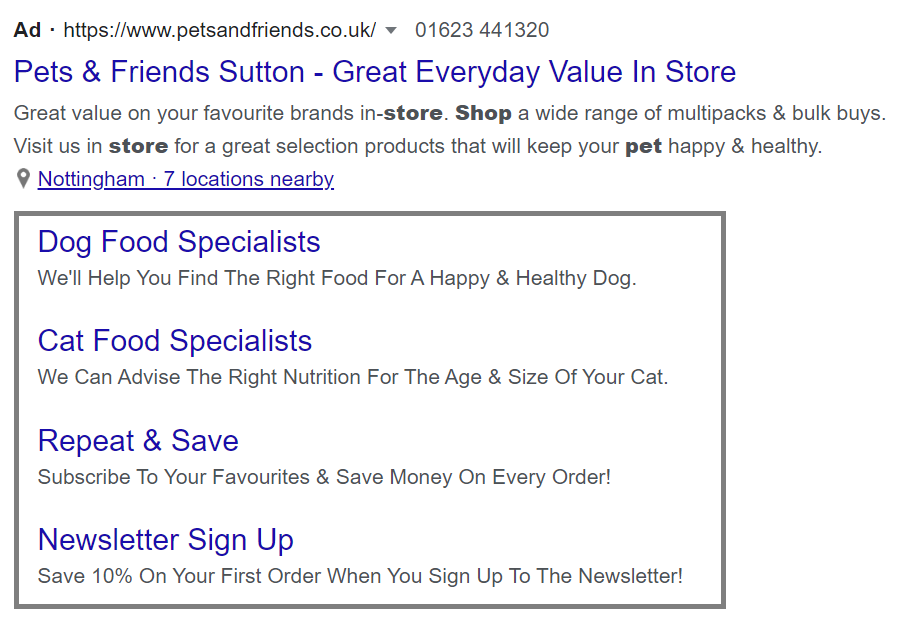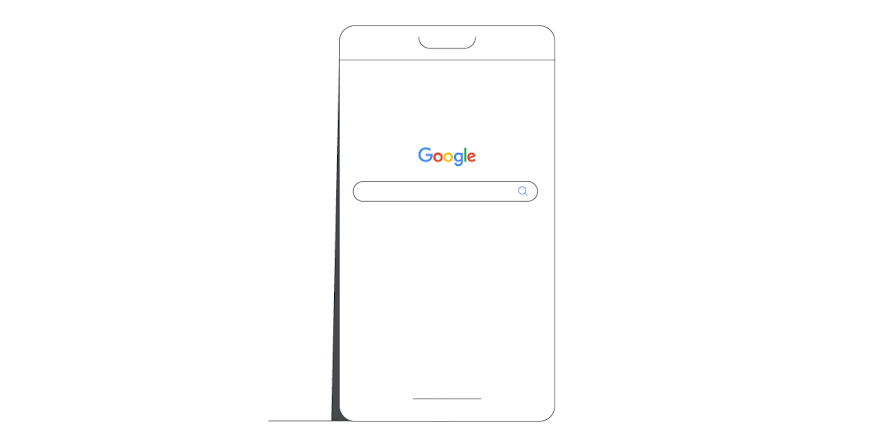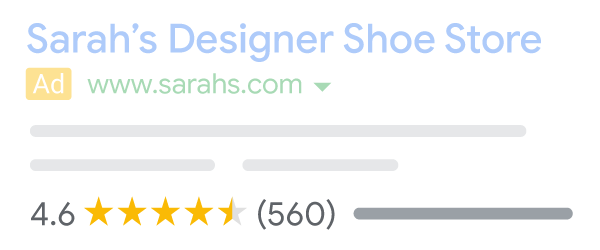joe@candiddigital.co.uk
June 16, 2025
If you are using a Google Ads account you will inevitably be on the lookout for ways to create incremental gains in performance. You are probably familiar with writing ad copy, optimising keyword targeting options and bid strategies. A way to almost guarantee an increase in performance if used correctly is to use Google Ad Extensions.
Google Ad Extensions allows advertisers to take up more space on a results page. Simultaneously providing more information about your company whilst leaving less space in the search results for competitors.
It might be you already know about Ad Extensions, if so then great. However, did you know that Google are always adding more ad extensions. Currently there are over 10 manual ad extensions available, alongside a number of automated extensions.
So, let’s begin.
Let’s start with the basics. Ad extensions allow you to expand Google ads with additional information to assist customers when appearing in results.
To quote Google:
Extensions expand your ad with additional information, giving people more reasons to choose your business. These may increase an ad’s clickthrough rate by several percentage points.
In essence, ad extensions extend your ads to take up more space within search engine results pages. Therefore extensions give advertisers the ability to exceed content limits. Everyone in advertising likes more content, right?
Most Google Ads extensions can be managed from directly within a Google Ads account. There are however some exceptions that we will cover within the article.
To view ad extension options navigate to Ads & Extensions from within the Google Ads account. This view makes it possible to see all of the ad extension possibilities. It is also possible to see the performance of any existing ad extensions.
Ad extensions fall into a variety of categories, some of triggered by proximity, search type, device or bid strategy. Whilst setting up the account correctly to show extensions is important, at times Google will decide when to show extensions and when not.
In this article we will cover the following extension types:
Every Google ads account should take advantage of ad extensions. Ad extensions provide users with additional information, take up more space within the SERPs and lead to a proven higher conversion rate.
Some of the extensions covered in the article will be applicable to all ad accounts, regardless of business objectives. Whilst we recommend taking advantage of as many extension types as possible it is best to prioritise those which will have the biggest impact.
Having ad extensions in an account will increase conversions rates, click through rates whilst providing a greater customer experience. On top of that, ad extensions are also free to add to your account.
Ad extensions also allow flexibility in messaging at scale. When information is changed in a text ad it must be changed everywhere it appears, by using ad extensions the messaging can be managed centrally. Therefore, changes can be made at scale across an account.
For an ad extension to be classified as manual it must be manageable within an ads account.
An account can take advantage of a number of manual extension types:
A location extension allows advertisers the ability to add a clickable address to an ad. Business location extensions are always displayed on new lines. This can have a significant impact on the amount of screen time taken up by the ad.

If multiple store locations are available then they are grouped and when clicked will show Google Maps overview of all the store locations.
A location extension can be applied to the account automatically and is great for businesses that rely on in-person transacting.
Location extensions will only be shown when a search is considered to be in a reasonable distance to the business.
An affiliate location extension is very similar to a typical location extension. However, affiliate location extensions allow an advertiser to show the location of a retail store that sells the product.
Affiliate location extensions can be really effective for brands that work with a retail network to sell the products. Helping a customer to find nearby locations to purchase products.
To setup an affiliate location extension simply navigate to extensions within the account and add a new affiliate location. From here specify which retailer should show.
Similar to location extensions, affiliate location extensions only show when a search is within a relevant distance.
You will probably be able to guess the use of a call extension? As you probably guessed, call extensions show a phone number with a Google ad. A great benefit of a call extension is that when triggered on mobile users can click to call directly.
There are some interesting things to know about call extensions:
Using call extensions is a great way to get customers in contact with you, particularly if you are a service lead company or require phone conversations with customers.
Google advise to not include phone numbers in ad text. In many cases this will cause an ad to be rejected. Therefore the best way to include a phone number is to use a call extension.
A sitelink extension gives advertisers the ability to significantly increase ad space by showing multiple links to different pages on the site.

When using sitelinks it is best to provide a variety of high value entry points to potential visitors. Similar to other ad extensions, sitelinks are assigned at either an ad group, campaign or account level.
Historically, sitelinks at a lower level within the account would always be served over sitelinks at higher levels. However, as of March 2022 Google will now use account level sitelinks above ad group sitelinks where it is expected to increase conversion rate.
We highly recommend using Sitelinks across the account due to the amount of extra space it gives the ad.
It is hard to think of an example of a situation where we wouldn’t recommend having sitelinks setup on an account.
App extensions are highly recommend if your business has an app. A link directly to the app is provided alongside the ad. This provides a link to users that will direct them to either the Google Play store or Apple App store. From there a user can directly download the app.
Adding an app extension is free to add and when clicked will be charged at a CPC in the same way as a direct app click.
Message extensions allow users to directly message the business from a search result. This can take a number of forms including “send us a text” or “message us for help”. Once clicked, customers will be sent directly to their messaging app with a prompt to contact the business.
Specifically, message extensions can be great for businesses trying to start engagement with potential customers. We recommend to use this alongside the call extension to really drive engagement.
Structure snippets are extensions that highlight specific aspects of your products and services. A snippet has two parts, the header and values.
Google provide a list of available headers:
Therefore it is important to consider if a structured snippet option is relevant for your business.
As with most extensions, there is no additional costs to adding structured snippet extensions. The ad cost per click is the same with or without the extensions.
Google use algorithms to determine when the structured snippet extension will show.
A lead extension, similar to call extensions & message extensions allows customers to contact your business without visiting the website.

If signed into your Google account the details will be automatically populated when opened.
In order to take advantage of lead extensions you need to provide a privacy policy link to Google as well as showcasing a good history of policy compliance. On top of that, lead extensions are not available in all sectors due to sensitivity of certain markets.
As with a number of lead extensions are available across search ads, display ads, discovery & video ads.
The benefit of a callout extension is that it allows advertisers to advertise special deals to customers, like free shipping or round-the-clock customer service. Customers that view your advertisements learn in-depth information about your company, products, and services.
When created a callout extension will run alongside your advertisement on a computer or mobile device. Depending on the character spacing, browser and device you’re using, you can show up to ten callouts alongside your ad text. In Google search results, callout extensions can be displayed at the top and bottom of the page.
Callout extensions offer a number of benefits, mainly in highlighting business benefits across entire ad accounts or campaigns.
Price extensions are a way to include pricing of products or services on search ads, Like other ad extensions it means the ad takes up more space whilst offering more information to potential customers.
In addition, a price extension click will take a customer directly to the website.
A promotion extension will show below an ad and shows customers relevant promotions about the business. This is therefore a great way to advertise short term promotions or events that are running.
As with most extensions, promotion extensions can be applied at an account, campaign or ad group level. Also, a promotion extension can be edited without losing data.
Finally, promotion extensions can be scheduled to show at specific times of day, days of week or have a start and end date.
An automated Google ad extension is an extension that Google will ad to your account automatically. Surprising, we know.
Whilst applied automatically, there is the option to turn automated ad extensions on and of within the account.
Google will choose to show these ad extension types when there is a chance it may improve performance.
There are a number of automated ad extension types, these include:
You will most likely recognise these extension types. As they are simply an automated or dynamic version of a manually added extensions.
We do, however, want to highlight one automated extension type that has (so far) not been covered.
Introducing…
Seller ratings allow for customer reviews to be shown directly in a variety of different Google ad types.

A seller rating will include:
Seller ratings are proven to significantly impact ad performance. However, there are a number of requirements needed in order to be eligible.
In order to be eligible for seller reviews on ads you mush have:
To find out if you have a seller rating use this URL, changing “yourwebsite” to your home page URL:
https://www.google.com/shopping/ratings/account/lookup?q={yourwebsite}
For a rating to be eligible it must be on the list of Googles independent review sites.
In conclusion, we could not recommend using ad extension more. They have a proven impact on ad performance, conversion & in some cases will lower cost per clicks.
If you are unsure how to take full advantage of ad extensions, get in touch with our expert team.
If you have an idea in mind, feel free to reach out by submitting the form below to schedule a discovery call with us.